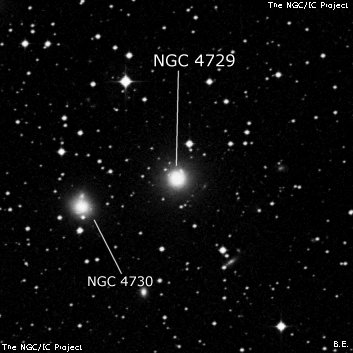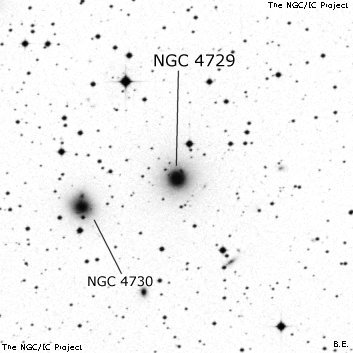NGC/IC Project Restoration Effort
(This is a very very beta version)
NGC4729


Basic Information
Location and Magnitude
Right Ascension: 12:51:46.2
Declination: -41:7:56
Constellation: CEN
Visual Magnitude: 12.3
Historic Information
Discoverer: Herschel J.
Year of discovery: 1834
Discovery aperture: 18.3
Observational
Summary description: neb, 1st of 3 p, a little s of h 3433
Sub-type: E0
Corwin's Notes
=====
NGC 4729 and NGC 4730. This problem arose because John Herschel's original
observations of 8 June 1834 yielded only very rough estimates of the positions
of the two galaxies (see his Results of Observations...at the Cape of Good
Hope... of 1847 for more information.) Inasmuch as the two galaxies were not
observed again until 1920, Dreyer had no choice but to use Herschel's rough
places when the NGC was prepared for publication in 1888.
Ron Buta came across this same problem some years ago during his
classification of galaxies on the Whiteoak PSS extension. In a letter of 3
Aug 1977, he suggested that the galaxies at 12 49 00.2 -40 51 33 (= ESO
323-G16, 1950 positions) and 12 49 14.0 -40 52 32 (= EU 323-G17) are N4729 and
N4730, respectively. Andris Lauberts came to the same conclusion at about the
same time when he was preparing ESO/Upps List VI. I entirely agree with their
suggestions as these are the two brightest and most easily seen objects
south-preceding NGC 4744 where Herschel noticed them.
The two galaxies are Vidal and Wickramasinghe's B and C, respectively. (By
the way, VW's D = N4744 and E = N4743). Jack Sulentic's incorrect RNGC
identifications refer to VW's "N3" and "N4", and Dawe et al are also wrong:
in their list (1970 positions), 12 50 24 -40 59 54 = N4729 and 12 50 38, -41
00 46 = N4730.
More confusion: under the designation HB 288 (more on that in a moment),
Sandage (Ap. J. 202, 563, 1975) gives the position of N4729, but the velocity
of N4730 (compare VW and Dawe et al). Unfortunately, the de Vaucouleurs and I
directly copied this mismatch into the Second Reference Catalogue (where the
data are under the single listing for "A1248-40") and Sandage simply repeated
his data in his redshift list in A.J. 83, 904, 1978.
Finally, the "HB" designations come from a series of papers by Knox-Shaw,
Gregory, and Madwar in the Helwan (formerly Khedivial) Observatory Bulletins
Nos. 9, 15, 21, 22, 30, and 38. N4729 - 30 were noted by Gregory in Bulletin
No. 22 as "Not found". However, among the (mostly!) new nebulae noted on the
Helwan plates, Gregory suggested that Helwan Bulletin nebulae Nos. 281, 282,
or 283 might be N4729 or N4730. De Vaucouleurs (in Commonwealth Obs. Memoirs
No. 13, his southern Shapley-Ames revision) concurs, but adds No. 288 as a
possibility. (He also confuses the nomenclature problem even further by using
"HB" for Harvard Bulletin! What a mess.) Actually, N4729 = Helwan Bulletin
288 and N4730 = HB 289.
Steve's Notes
=====
NGC 4729
17.5" (4/7/89): very faint, small, oval NW-SE. A mag 13 star is 1.0' N. Forms a close pair with NGC 4730 2.8' ESE. Located within the Centaurus Cluster (AGC 3526). Misidentified in the RNGC as ESO 323-008.



